The Bulldozer Review: AMD FX-8150 Tested
by Anand Lal Shimpi on October 12, 2011 1:27 AM ESTThe Test
To keep the review length manageable we're presenting a subset of our results here. For all benchmark results and even more comparisons be sure to use our performance comparison tool: Bench.
| Motherboard: |
ASUS P8Z68-V Pro (Intel Z68) ASUS Crosshair V Formula (AMD 990FX) |
| Hard Disk: |
Intel X25-M SSD (80GB) Crucial RealSSD C300 |
| Memory: | 2 x 4GB G.Skill Ripjaws X DDR3-1600 9-9-9-20 |
| Video Card: | ATI Radeon HD 5870 (Windows 7) |
| Video Drivers: | AMD Catalyst 11.10 Beta (Windows 7) |
| Desktop Resolution: | 1920 x 1200 |
| OS: | Windows 7 x64 |
Windows 7 Application Performance
3dsmax 9
Today's desktop processors are more than fast enough to do professional level 3D rendering at home. To look at performance under 3dsmax we ran the SPECapc 3dsmax 8 benchmark (only the CPU rendering tests) under 3dsmax 9 SP1. The results reported are the rendering composite scores.

As our first heavily threaded, predominantly FP workload we see the FX-8150 come out swinging. A tangible upgrade from the Phenom II X6, the 8150 is hot on the heelds of the Core i5 2400, however it is unable to compete with the 2500K and 2600K.
Cinebench R10 & 11.5
Created by the Cinema 4D folks we have Cinebench, a popular 3D rendering benchmark that gives us both single and multi-threaded 3D rendering results.
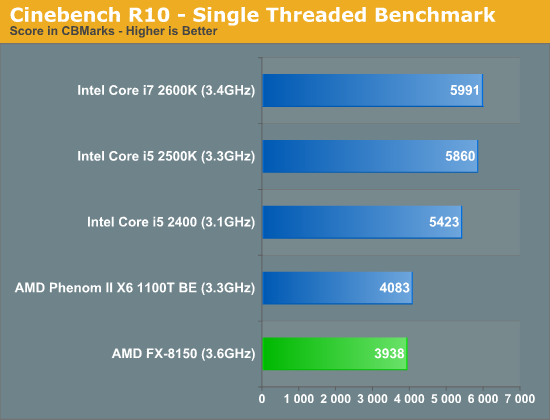
As I alluded to earlier, single threaded performance is going to be a bit of a disappointment with Bulldozer and here you get the first dose of reality. Even considering its clock speed and Turbo Core advantage, the FX-8150 is slower than the Phenom II X6 1100T. Intel's Core i5 2500K delivers nearly 50% better single threaded performance here than the FX-8150.
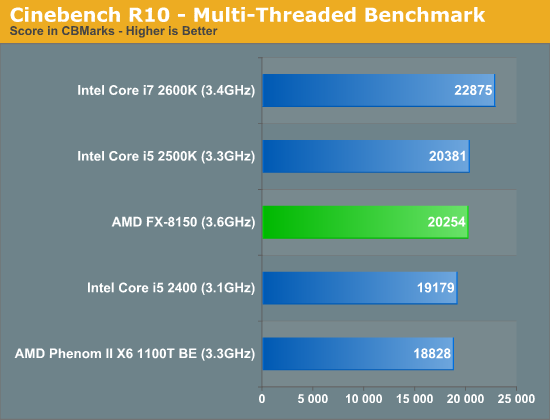
Crank up the threads and the FX-8150 shines, finally tying the 2500K at a comparable price point.
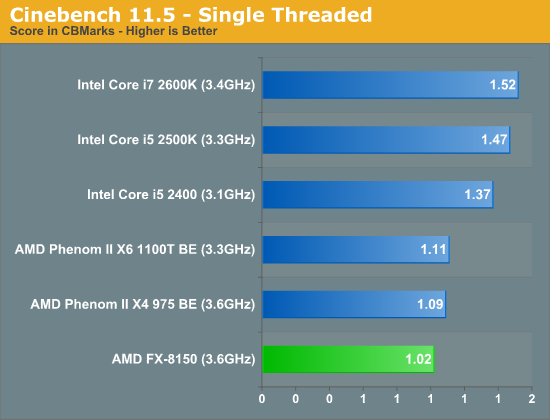
Even with more modern workloads, the FX-8150 isn't able to compete in single threaded speed. Here the 2500K is 44% faster.
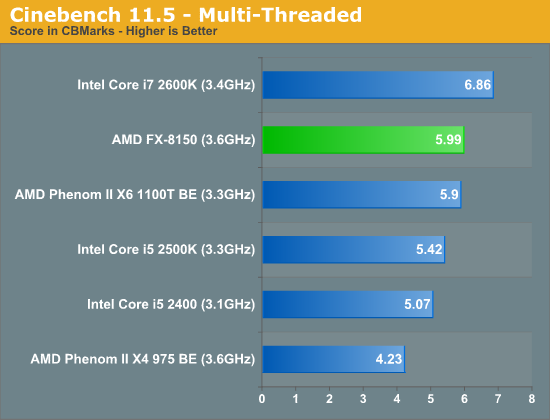
Modern multithreaded workloads however do quite well on Bulldozer. The gains over the old Phenom II X6 1100T are unfortunately not as large as we would expect them to be.
7-Zip Benchmark
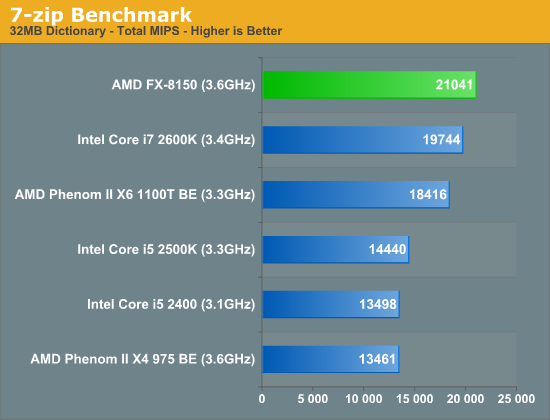
Heavily threaded workloads obviously do well on the FX series parts, here in our 7-zip test the FX-8150 is actually faster than Intel's fastest Sandy Bridge.
PAR2 Benchmark
Par2 is an application used for reconstructing downloaded archives. It can generate parity data from a given archive and later use it to recover the archive
Chuchusoft took the source code of par2cmdline 0.4 and parallelized it using Intel’s Threading Building Blocks 2.1. The result is a version of par2cmdline that can spawn multiple threads to repair par2 archives. For this test we took a 708MB archive, corrupted nearly 60MB of it, and used the multithreaded par2cmdline to recover it. The scores reported are the repair and recover time in seconds.
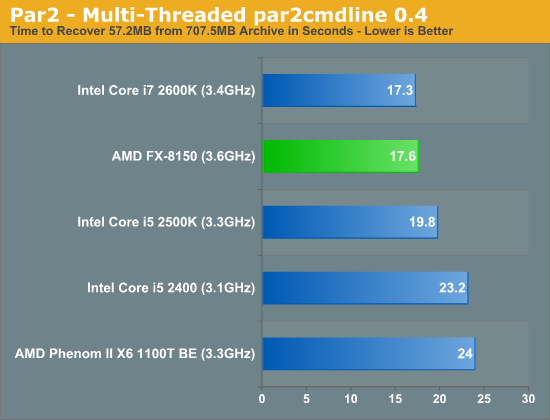
Once again, throw more threads at the processor and the FX-8150 can outperform the Core i5 2500K.
TrueCrypt Benchmark
TrueCrypt is a very popular encryption package that offers full AES-NI support. The application also features a built-in encryption benchmark that we can use to measure CPU performance with:

Bulldozer adds AES-NI acceleration, a feature that wasn't present in the Phenom II X6. As a result the FX-8150 is among the fastest at real time AES encryption/decryption, second only to the 2600K. Intel's artificial segmentation using Hyper Threading comes back to haunt it here as the 2500K is significantly slower than the 8-threaded beast.
x264 HD 3.03 Benchmark
Graysky's x264 HD test uses x264 to encode a 4Mbps 720p MPEG-2 source. The focus here is on quality rather than speed, thus the benchmark uses a 2-pass encode and reports the average frame rate in each pass.
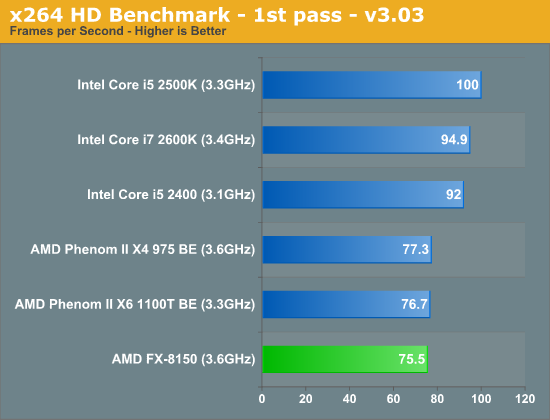
As I mentioned earlier, the first pass of our x264 HD benchmark is a lightly threaded task. As such, the FX-8150 doesn't do very well here. Even the old Phenom II is able to inch ahead of AMD's latest. And Sandy Bridge obviously does very well.
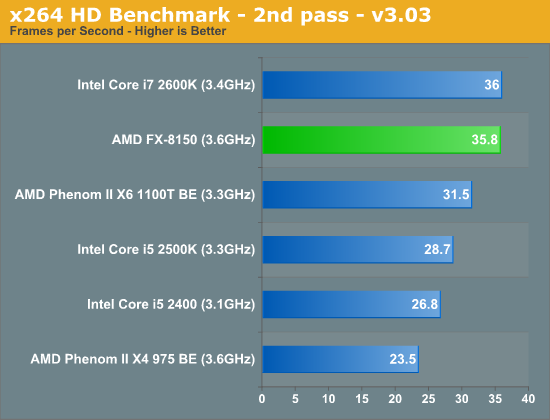
The second pass is more thread heavy, allowing the FX-8150 to flex its muscle and effectively tie the 2600K for first place.
AMD also sent along a couple of x264 binaries that were compiled with AVX and AMD XOP instruction flags. We ran both binaries through our x264 test, let's first look at what enabling AVX does to performance:

Everyone gets faster here, but Intel continues to hold onto a significant performance lead in lightly threaded workloads.
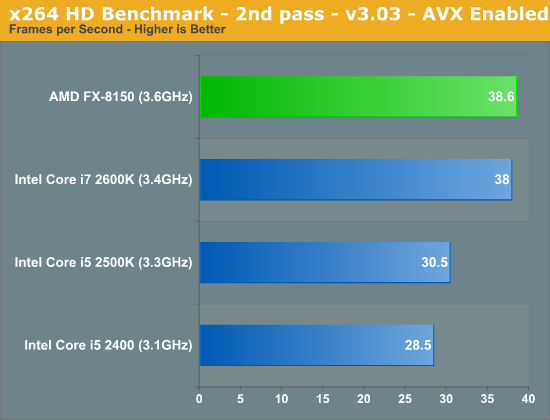
The standings don't change too much in the second pass, the frame rates are simply higher across the board. The FX-8150 is an x86 transcoding beast though, roughly equalling Intel's Core i7 2600K. Although not depicted here, the performance using the AMD XOP codepath was virtually identical to the AVX results.
Adobe Photoshop CS4
To measure performance under Photoshop CS4 we turn to the Retouch Artists’ Speed Test. The test does basic photo editing; there are a couple of color space conversions, many layer creations, color curve adjustment, image and canvas size adjustment, unsharp mask, and finally a gaussian blur performed on the entire image.
The whole process is timed and thanks to the use of Intel's X25-M SSD as our test bed hard drive, performance is far more predictable than back when we used to test on mechanical disks.
Time is reported in seconds and the lower numbers mean better performance. The test is multithreaded and can hit all four cores in a quad-core machine.
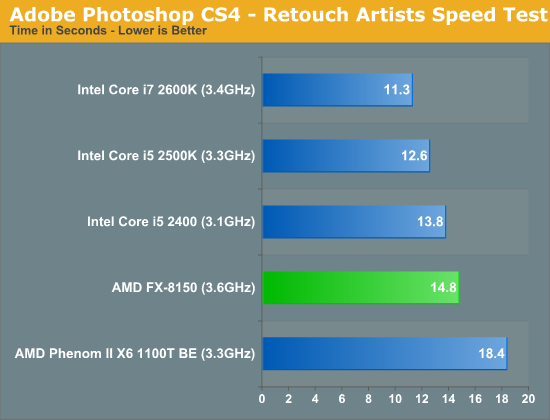
Photoshop performance improves tangibly over the Phenom II X6, unfortunately it's not enough to hang with the enthusiast Sandy Bridge parts.
Compile Chromium Test
You guys asked for it and finally I have something I feel is a good software build test. Using Visual Studio 2008 I'm compiling Chromium. It's a pretty huge project that takes over forty minutes to compile from the command line on a dual-core CPU. But the results are repeatable and the compile process will easily stress more than 8 threads on a CPU so it works for me.
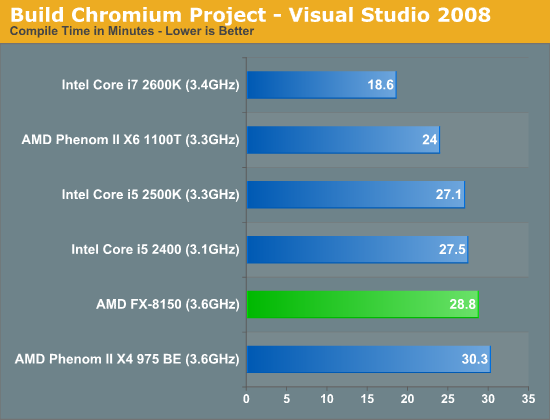
Our compiler test has traditionally favored heavily threaded architectures, but here we found the Phenom II X6 1100T to offer a tangible performance advantage over Bulldozer. While AMD is certainly competitive here, this is an example of one of those situations where AMD's architectural tradeoffs simply don't pay off—not without additional clock speed that is.
Excel Monte Carlo
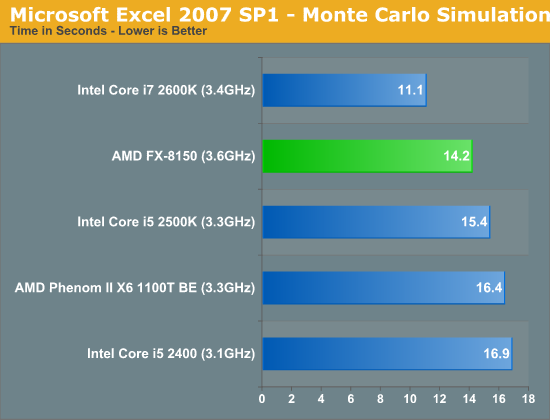
Our final application test is another win for AMD over the Core i5 2500K. The victory is entirely a result of Intel's Hyper Threading restrictions though, the eight-thread 2600K is able to easily outperform Bulldozer. Either way, AMD delivers better performance here for less money.










430 Comments
View All Comments
Kristian Vättö - Wednesday, October 12, 2011 - link
I'm happy that I went with i5-2500K. Performance, especially in gaming, seems to be pretty horrible.ckryan - Wednesday, October 12, 2011 - link
I was just going to say the same thing. I was all about AMD last year, but early this year I picked up an i5 2500K and was blown away by efficiency and performance even in a hobbled H67. Once I bought a proper P67, it was on. It's not that Bulldozer is terrible (because it isn't); Sandy Bridge is just a "phenom". If SB had just been a little faster than Lynnfield, it would still be fast. But it's a big leap to SB, and it's certainly the best value. AMD has Bulldozer, an inconsistent performer that is better in some areas and worse in others, but has a hard time competing with it's own forebearer. It's still an unusual product that some people will really benefit from and some wont. The demise of the Phenom II can't come soon enough for AMD as some people will look at the benchmarks and conclude that a super cheap X4 955BE is a much better value than BD. I hope it isn't seen that way, but it's not a difficult conclusion to reach. Perhaps BD is more forward looking, and the other octocore will be cheaper than the 8150 so it's a better value. I'd really like to see the performance of the 4- and 6- before making judgement.It's still technically a win, but it's a Pyrrhic victory.
ogreslayer - Wednesday, October 12, 2011 - link
I tell friends that exact thing all the time. Phenoms are great CPUs but switch to Nehelam or Sandy Bridge and the speed is noticibly different. At equal clocks Core 2 Quads are as fast or faster.Bulldozer ends up with a lot of issues fanboys refused to see even though Anandtech and other sites did bring it up in previews. I guess it was just hope and a understandable disbelief that AMD would be behind for a decade till the next architecture. We can start at clockspeed but only being dual-channel is not helping memory bandwidth. I don't think there is enough L3 and they most definitely should have a shortpipeline to crush through processes. They need an 1.4 to 1.6 in CBmarks or what is thhe point of the modules.
The module philosophy is probably close to the future of x86 but I imagine seeing Intel keeping HT enabled on the high-end SKUs. Also I think both of them want to switch FP calculation over to GPUs.
slickr - Wednesday, October 12, 2011 - link
Yeah I agree. To me Bulldozer comes like 1 year late.Its just not competitive enough and the fact that you have to make a sacrifice to single threaded performance for multithreaded when even the multithreaded isn't that good and looses to 2600K is just sad.
They needed to win big with Bulldozer and they failed hard!
retrospooty - Wednesday, October 12, 2011 - link
Ya, it seems to be a pattern lately with the last few AMD architectures.1. Hype up the CPU as the next big thing
2. Release is delayed
3. Once released, benchmarks are severely underwhelming
JasperJanssen - Wednesday, October 12, 2011 - link
4. Immediately start hyping up the next release as the salvation of all.GatorLord - Thursday, October 20, 2011 - link
It looks to me like BD is the CPU beta bug sponge for Trinity and beyond. Everybody these days releases a beta before the money launch.Hence the B3 stepping...and probably a few more now that a capable fab is onboard with TSMC. BD is not a CPU like we're used to...its an APU/HPC engine designed to drive code and a Cayman class GPU at 28nm and lots of GHz...I get it now.
Also, the whole massive cache and 2B transistors, 800M dedicated to I/O, thing (SB uses 995M total) finally makes sense when you realize that this chip was designed to pump many smaller GPGPU caches full of raw data to process and combine all the outputs quickly.
Apparently GPUs compute very fast, but have slow fetch latencies and the best way to overcome that is by having their caches continously and rapidly filled...like from the CPU with the big cache and I/O machine on the same chip...how smart..and convenient...and fast.
Can you say 'OpenCL'?
jleach1 - Friday, October 21, 2011 - link
I don't see how this can be considered an APU, This product isn't being marketed as a HPC proc., and i don't see the benefit of this architecture design in GPGPU environments at all.It's sad...i've always given major kudos to AMD. Back in the days of the Athlon's prime, it was awesome to see david stomping goliath.
But AMD has dropped the ball continuously since then. Thuban was nice, but it might as well be considered a fluke, seeing as AMD took a worthy architecture (Thuban) and ditched it for what's widely considered as a joke.
And the phrase "AMD dropped the ball" is an understatement.
They've ultimately failed. They havent competed with Intel in years. They...have...failed. After thuban came out i was starting to think that the fact that they competed for years on price and clock speed alone was a fluke, and just a blip on the radar. Now i see it the opposite way...it seems that AMD merely puts out good processors every once in a while...and only on accident.
medi01 - Wednesday, October 12, 2011 - link
Well, if anand didn't badmouth AMD's GPU's on top of CPU's, we would see less "fanboys" complainging about anand's bias.vol7ron - Wednesday, October 12, 2011 - link
By badmouth do you mean objectively tell the truth? Do you blame PCMark or FutureMark for any of that? Perhaps if all the tests just said that AMD was clearly better, it wouldn't be badmouthing anymore.